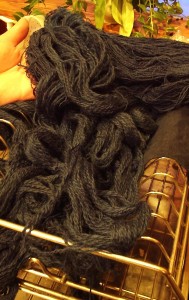You want to know if a common plant is a good natural dye. How do you tell? There are three criteria which a natural dye needs to have to be considered worthwhile: ease of use and gathering, wash fastness, and light fastness. With this post I will share with you one method for testing natural dyes for colour fastness.
My personal experiment with natural indigo light and wash fastness tests
When researching woad an indigo I did a wash and light fastness test with natural indigo dyed skeins of wool and cotton. Indigo has a different molecular structure then other natural dyes. This made the results interesting. Cotton faded the most with both light and washing. Wool did not fade with light – only with washing. Light fastness was very good for the indigo. Wash fastness was not very good. This is due to the chemical structure.
In my experiment I used three test skeins of each fiber type. The experiment lasted for one week, during which time the wash skeins were washed twice a day. The light fastness skeins remained in a southern window constantly. Unlike testing a standard natural dye, indigo does not use a mordant due to its chemical structure.
Procedure for both wash and light fastness tests
To colour fastness test unknown natural dyes:
Gather enough of the plant material to equal the dry weight of the fiber to be dyed. Prepare as a normal natural dye vat. If using a mordant, alum should be used. Alum is the safest mordant. Alum is also the only colourless mordant and has little or no impact on dyed colour.Other mordants, such as iron give their own colour to the dyed yarn or other fiber preparation.
Wool should be washed with soap to remove dirt and grease, and rinsed so that it is close to pH neutral.
Loosely tie three skeins of yarn. Strips of fabric, or sections of washed raw wool also work. Dye samples at the same time. Then the colours are as close as possible. This is important since the colours will need to be compared to show how fast the dye is.
After the skeins are dry set aside one skein (or other sample) as a control. This skein should be put in a brown paper bag. It is best if this bag is stored out of direct light, in a drawer. This control skein should remain out of light until the end of the fastness test.
The second skein is the light fastness test. It should be placed in a sunny windowsill. A south or western window is good. This skein should remain in the sun until the end of the test.
The final skein is the wash fastness test. It should be washed two times a day. The washing is the same as you would wash a garment made from that fiber. The skein should dry completely between washings. This simulates how the natural dye would respond in a garment.
How to remember the natural dye fastness test results
This type of experiment can be added to your natural dye journal. Yarn samples or pictures both work. This enables you to see at a glance which plants you have tested and which plants are colour fast. You can also take pictures of the freshly dyed samples and compare them with samples which have been in use, to see how they fade. The picture method helps if you don’t want to have wool samples lying around.
Back to you
What is your natural dye adventure? Have you ever tested a natural dye for colour fastness, what were the results? I would love to hear from you. Leave a comment.

I have been experimenting with purple cabbage dye and changing the ph levels. Seems to be all good for lightfastness so far. Wow what a great range of colors from it too. From pink, purple to blues. pinks add vinegar, for blues add baking soda. Silk seems to hold it best. 🙂
Have you tried testing it for washfastness yet? Silk does hold dye better than wool, and cotton is worse than both for holding colour. The colour from purple cabbage is an anthocyanin which means the colour changes depending on pH, and may change when washed if the pH is different. Thanks for commenting.
Sarah.